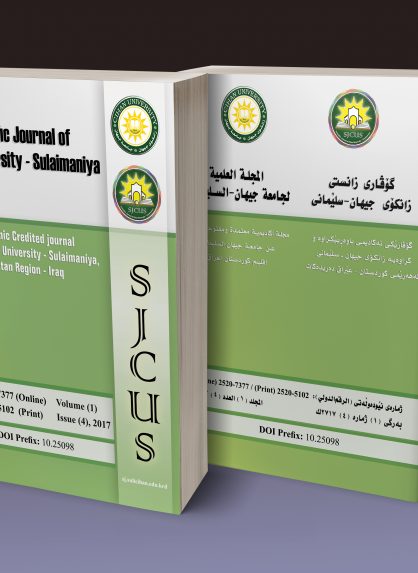| published |
| DOI |
كاروان عمر قادر
بهشی كوردی – كۆلێژى زمان – زانكۆی سلێمانى- سلێمانی – عێراق
[email protected]
Karwan Omar Kadir
Kurdish Department, Faculty of Linguistics, Slemani University, Sulaimanyia, Iraq
Received :12-11-2018 Revised:3-2-2019
Accepted :5-3-2019 Published :30-6-2019
Abstract
The current research “Network of Words in Word Grammar” intents to interpret and analyze the opinion that Kurdish language like any language has a blending structure of nodes and Links, which make it network component. The main unit of this network is a Word, which organizes the connection between speech and comprehension in language. According to this view, the words are a node that connect all the parts and pieces of the language and make it like a network. For the achievement and investigation of these goals, the research followed the theory of (Word Grammar) in the framework of the school of (Cognitive Linguistics). The research tries to analyses theoretically and practically the node and links of network words in Kurdish language. The research is divided into four sections: The first section is entitled “Kurdish Language as Network of concepts”, ventures to represent and evaluate the network hypotheses theoretically and practically especially in Kurdish language. The second section entitled “Word Grammar Perception to Modularity of Concept”, attempts to practically illustrate the perspective of modularity of network of concept in Kurdish language. The third section entitled “Default Inheritance in Kurdish Grammar Network”, attempt to analyses the hypotheses of “Default Inheritance” theoretically, then the research practically try to reanalyze and represent this hypotheses in configuration of Kurdish grammar network. The fourth and last section entitled “Cognition of Morphology Network in Kurdish Language”, endeavors to confirm the network hypotheses in morphology of Kurdish Grammar.
پوخته:
ئهم لێكۆڵینهوهیه بهناوى (تهنینى وشهیى له ڕێزمانى وشهییدا) ههوڵى لێكدانهوه و شیكردنهوهى ئهو بیرۆكهیه دهدات، كه زمانى كوردیش وهك ههر زمانێكى تر خاوهنى داڕشتهیهكى ئاوێتهكراوى (گرێ و هێڵهگرێدهره)كانه، كه پێكهاتهى تۆڕبهندى زمانى كوردى پێكدێنن. یهكهى سهرهكى ئهم تۆڕبهندهش وشهیه، كه پهیوهندى نێ,ان ئاخاوتن و تێگهیشتن له زماندا دهڕهخسێنێت. لهم ڕوانگهیهوه وشهكان بریتین له گرێیهكان، كه ههموو بهش و پارچهكانى زمانهكه پێكهوه دهلكێنێت و دهیكاته تۆڕبهندێك. به مهبهستى لێكۆڵینهوه و گهیشتن بهم ئامانجه، لێكۆڵینهوهكه پهیڕهوى تیۆرى (ڕێزمانى وشهیى) له ناو قوتابخانهى زمانهوانى (زانستى زمانى دركپێكردن) كردووه. لێكۆڵینهوهكه ههوڵیداوه به شێوهیهكى تیۆرى و كارهكییانه شیكردنهوه بۆ گرێ و هێڵهگرێدهرهكانى تۆڕبهندى وشهكان له زمانى كوردیدا بكات. ههر بۆ ئهم مهبهستهش لێكۆڵینهوهكه به سهر چوار تهوهرهدا دابهشكراوه: تهوهرهى یهكهم به ناونیشانى (زمانى كوردى وهك تۆڕبهندێكى چهمكییانه) یه و تێیدا ههوڵدراوه به شێوهیهكى تیۆرى و كارهكى گریمانهى تۆڕبهندى زمان شیبكرێتهوه و بنوێنرێت به تایبهتى له زمانى كوردیدا. تهوهرهى دووهمى ئهم لێكۆڵینهوهیهش بۆ سهرناوى (دركپێكردنى ڕێزمانى وشهیى بۆ مۆدولارێتى چهمكیلهكانى چهمك) تهرخانكراوه، كه تێیدا ههوڵدراوه به شێوهیهكى كارهكى ڕوانگهى مۆدولارێتى تۆڕبهندى چهمك بخرێتهڕوو. تهوهرهى سێیهمى ئهم لێكۆڵینهوهیهش بۆ سهرناوى (میراتى گریمانهیى تۆڕبهندى ڕێزمانى كوردى) تهرخانكراوه، كه تێیدا ههوڵدراوه تیۆرى (میراتى گریمانهیى) به شێوهیهكى تیۆرییانه شیبكرێتهوه و دواتر لێكۆڵینهوهكه ههوڵیداوه به شێوهیهكى كارهكى شرۆڤهى تیۆرییهكه له ڕوانگهى داڕشتهى تۆڕبهندى ڕێزمانى كوردییهوه بكات. ههرچى تهوهرهى چوارهمى ئهم لێكۆڵینهوهیهشه بۆ سهرناوى (دركپێكردنى تۆڕبهندى مۆرفۆلۆژى زمانى كوردى) تایبهتكراوه، كه تێیدا ههوڵدراوه به شێوهیهكى كارهكى جهخت له دروستى گریمانهى تۆڕبهندیى بكرێتهوه له داڕشتهى مۆرفۆلۆژى ڕێزمانى كوردیدا.
الملخص
إنَّ هذا البحث المُعَنوَن ب “شبكة من الكلمات في قواعد الكلمة” محاولة لتوضيح كون اللُّغة الكورديّة كغيرها من اللُّغات الأُخرى لديها تركيبة ممزوجة مكونة من شبكة واسعة متصلة الأجزاء. وإنَّ وحدة الأساس لهذه الشبكة هي الكلمة، والتي تنسق العلاقة بين الكلام والفهم في اللُّغة. وَفقًا لهذا المنطلق فإنَّ الكلمة هي نقطة اللقاء والربط شبكيًا بين جميع أجزاء اللُّغة. لذا من أجل الإنجاز والتحقيق انتهج البحث نظريّة قواعد الكلمة في إطار المدرسة اللُّغويّة -اللِّسانيّات المعرفيّة-. وانطلاقًا من هذا المنظور يتألف البحث من أربعة محاور: الأول “اللُّغة الكورديّة كشبكة مفهوميّة” حيث عُرِضَ فيه شرح وتقييم الرؤية الشبكيّة نظريًّا وعمليًّا في اللُّغة الكورديّة بشكل خاص. أما في المحور الثاني وعنوانه ” إدراك قواعد الكلمة لنمطيّة المفهوم” كان توضيحًا من الناحية الفعليّة لفهم وإدراك قواعد الكلمة لنمطيّة شبكة المفهوم في اللُّغة الكورديّة. أما المحور الثالث والذي يحمل عنوان ” الميراث الافتراضي لشبكة قواعد اللُّغة الكورديّة” قُدمِت فيه نظريًا فرضيّة الميراث لنظريّة قواعد الكلمة أولاً، وثانيًا تمَّ شرح وتقييم هذه الفرضيّة في تكوين الشبكة اللُّغويّة لقواعد اللُّغة الكورديّة عمليًا. وفي المحور الرابع والأخير بعنوان “معرفة الشبكة الصرفيّة في اللُّغة الكورديّة” تمَّ إثبات فرضيّة الشبكة لعلم الصرف في اللٌّغة الكورديّة.
سهرچاوهكان
1. ئهبوبهكر عومهر قادر (2003)، بهراوردێكى مۆرفۆسینتاكسى له زمانى كوردى و فارسیدا، نامهى دكتۆرا (بڵاونهكراوه)، زانكۆى سلێمانى، سلێمانى.
2. ئهبوبهكر عومهر قادر (2016)، ئهركى سێگمێنتى /ێ/ له مۆرفۆلۆژى و سینتاكسدا ، گۆڤارى زانكۆى سلێمانى، بهشى (B)، ژ. (51)ى ساڵى (2016).
3. لارس مێلین، و/ غازى عهلى خورشید (2008)، سایكۆلۆژیى زمان، بڵاوكراوهى ئهكادیمیاى كوردى، چاپخانهى حاجى هاشم، ههولێر.
4. كاروان عومهر قادر (2012) سیستهمى دركپێكردن وهك بنهمایهكى ڕێزمانى كوردى، گۆڤارى زانكۆى سلێمانى بهشى (B)، ژماره (34)، سلێمانى.
5. تاڵیب حوسێن عهلى (2011)، واتاسازى (چهند بابهتێكى لێكدانهوهى واتاى وشه)، چاپى یهكهم، چاپخانهى ڕۆژههڵات، ههولێر.
1. Allwood, j. and Gardenfors, P. (1999), Cognitive Semantics (Meaning and Cognition), John Benjamins publishing company.
2. Cutler, A. (2005), Twenty-First Century Psycholinguistics: Four Cornerstones, Lawrence Erlbaum Associates Publishers, Mahwah, New Jersey London.
3. Geeraerts, D. and Cuyckens, H. (2007), The Oxford Handbook of Cognitive Linguistics, Oxford University Press.
4. Green, M. and Evans, V. (2006), Cognitive Linguistics (An Introduction), Edinburgh University Press.
5. Hudson, R. (2007), Language Networks (The New Word Grammar), Oxford University Press.
6. Hudson, R. (2010), An Introduction to Word Grammar, Cambridge University Press.
7. Jakendoff, R. (2002), Foundation of Language (Brain, Meaning, Grammar, Evolution), Oxford University Press.
8. Kibbee,A., D. (2010), Chomskyan (R)evolutions, John Benjamins Publishing Company.
9. Kruijff, G., M. (2002), Formal & Computational Aspects of Dependency Grammar (Heads, dependents, and dependency structures), University of the Saarland, Saarbr¨ucken Germany.
10. Langacker, W., R. (2008), Cognitive Grammar (A Basic Introduction), Oxford University Press.
11. Morley, G., D. (2000), Syntax in Functional Grammar (An introduction to lexicogrammar in systemic linguistics), Continuum, London and New York.
12. Sugayama, K. and Hudson, R.(2006), WG ( New Perspective on a Theory of Language Structure), Published by Continuum Company.



